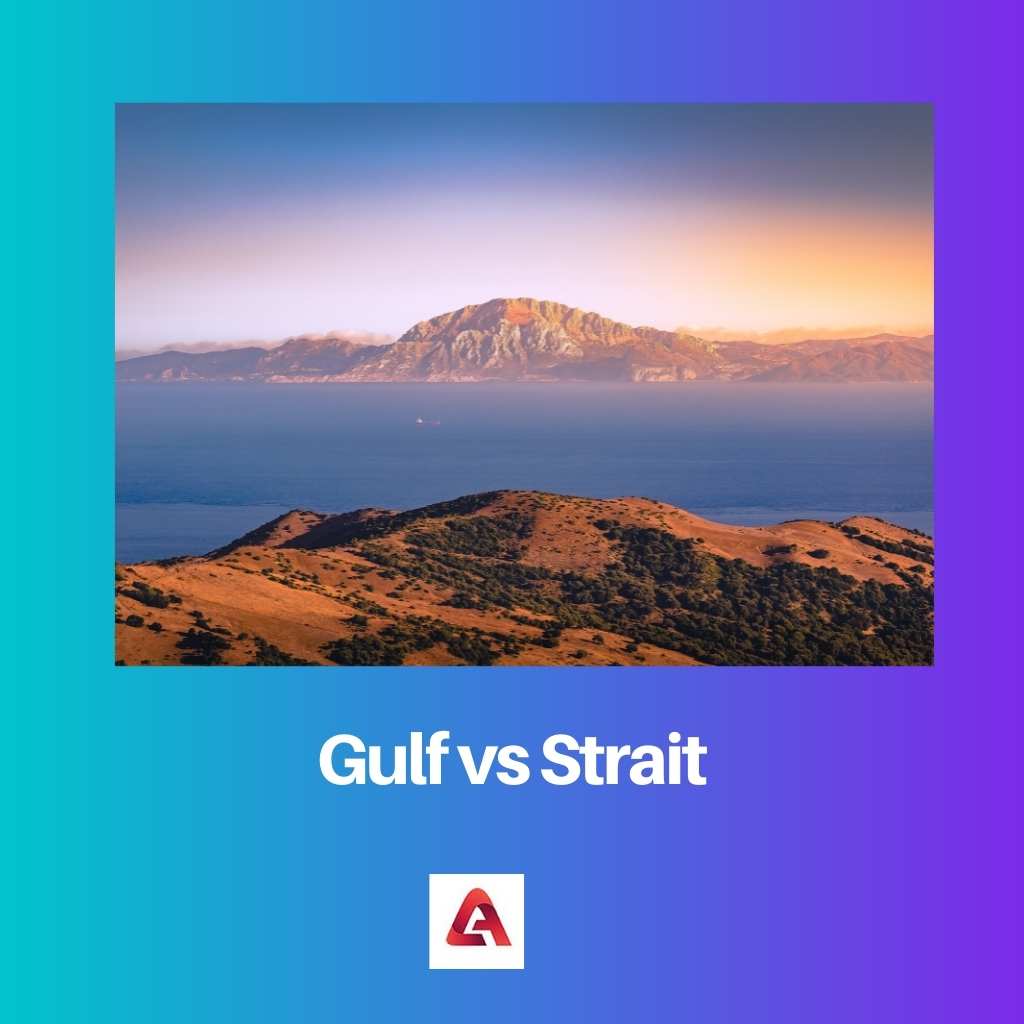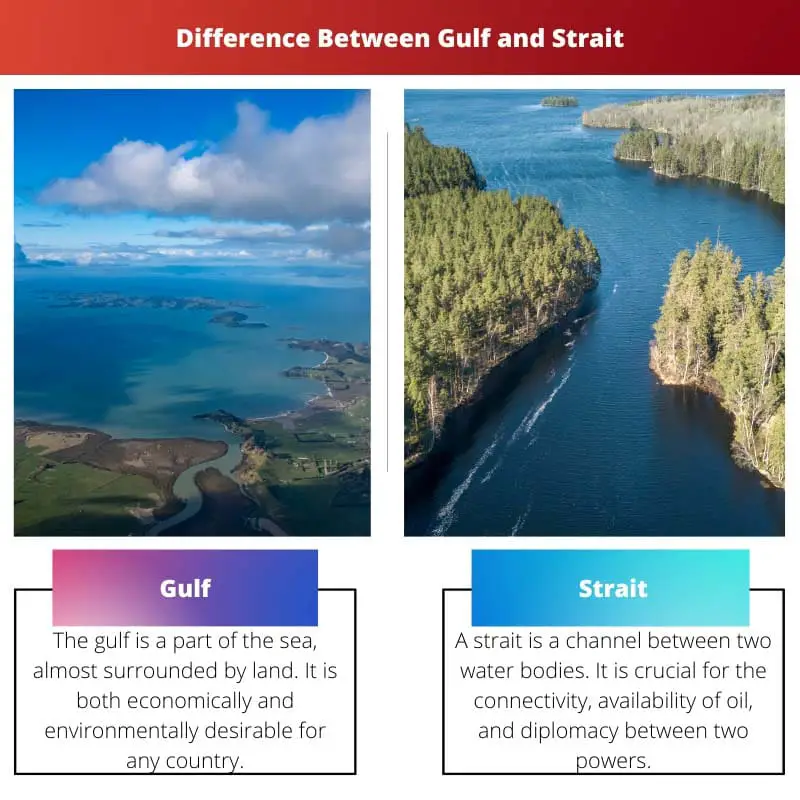Gulf and strait are landforms enclosed in the water body near land. Continental drift of the plates is responsible for their formations.
These landforms are located in important places of human habitations and are strategically important. They are a rich source of natural resources, food, trade and commerce.
Hence, human conflicts are inevitable.
Key Takeaways
- A gulf is a large body of water partially enclosed by land, forming a significant indentation along a coastline.
- A strait is a narrow, navigable waterway connecting two larger bodies of water, separating two land masses.
- Gulfs and straits involve bodies of water and land, but gulfs are characterized by their size and indentation, while straits connect larger waters and separate land areas.
Gulf vs Strait
A strait is a narrow waterway that connects two larger bodies of water and is used for navigation. It is formed by a channel that has been eroded by water over time. A gulf is a term used to describe a large bay that is an arm of an ocean or sea, surrounded by land on three sides.

The gulf is a part of the sea, almost surrounded by land. It is both economically and environmentally desirable for any country.
It serves as a key trading centre for the world. The continuous inward and outward flow of water makes it highly indented.
Hence, it proves to be the best harbour for ships coming from worldwide.
On the other hand, a strait is a channel between two water bodies. It is crucial for the connectivity, availability of oil, and diplomacy between two powers.
It provides the passage for trade diplomacy. For it is narrow and shallow, sediments obstructs and forbids the movement of ships between the continents.
Comparison Table
| Parameters of Comparison | Gulf | Strait |
|---|---|---|
| Definition | It is a part of the sea that enters the land. | It is the narrow waterway between two larger water bodies. |
| Connection | It connects the water and land forms. | It joins two oceans or seas |
| Use | Excellent for making harbours | Not profitable for making harbours |
| Formation | Its formation can be naturally by tectonic activity or erosion. | Its formation can be natural and artificial |
| Enclosure | Enclosure by three water bodies | Enclosed by two water bodies on either side |
What is Gulf?
A gulf is an inlet from the ocean into the continent. Some of the well-known Gulfs of the world are- The Gulf of Mexico, the Gulf of Finland, the Persian Gulf, Gulf of Aden.
These gulfs also act as the significant shipping areas of the world. Traditionally, a massive body of saltwater surrounded by coastline was called a gulf.
A gulf can be of different sizes, depths or shapes. They are highly indented and form excellent harbours.
Formation: The exact reason for its emergence is not known. However, geologists predict that the movement of the Earth can be a valid reason.
These movements may make or break the Earth’s crust by divergence or convergence, respectively. One of the processes is subduction, where the oceanic plate moves beneath the continental plates.
Thus, subduction leads to the formation of the gulf by creating troughs or downfolds beneath the ocean.
The Gulf of Mexico is the largest in the world. The Gulf of Mexico, surrounded by the United States, Mexico and the island of Cuba, is strategically important for these countries.
It’s significant for the upwelling process that happens near the Florida coast. Upwelling is the process in which the nutrient-rich waters of the lower level are brought to the surface, thus creating a variety of sea fishes.

What is Strait?
A strait is a landform that connects two oceans or an ocean and a sea or two seas. Some of the famous Straits of the world are- the Malacca Strait, Palk Strait, Bab-el-Mandeb Strait, and Bosporus Strait.
Straits play a significant role in trade and shipping. The term ‘Strait’ is used interchangeably as pass, passage or channel.
Some straits are navigable, and some are not, for they are too shallow. Sometimes, it may not be crossable for the presence of an archipelago or a reef or due to sediment accumulation.
A strait is significant for maritime trade, navigation, oil production, and geopolitics.
Formation: A split in the thin land boundary between the two large water bodies can form the strait. This split can be due to tectonic movements.
For example, the formation of the Strait of Gibraltar that links the Meditteranean sea and the Atlantic sea was by a tectonic drift.
The Strait of Malacca is the largest in the world. It joins the Andaman Sea & South China Sea. It is part of the maritime silk route and is the busiest strait.
The Sultanate of Malacca, who ruled over this archipelago, gave it its name.

Main Differences Between Gulf and Strait
- A gulf is an arm of the sea or ocean that penetrates the land. It is broader than a bay. A strait is a passage that bridges two bodies of water.
- A gulf is a combination of continent and ocean, but a Strait is the mingling of two oceans, two seas, or an ocean and a sea.
- The gulf is excellent for building harbours, whereas it is not wise to form any port near a strait. A strait acts as a locus for sedimentation deposition and, hence making a harbour may not be a good investment.
- A gulf is formed naturally over the years, while a strait can be natural or artificial. The construction of the Suez Canal in 1869, connecting the Mediterranean Sea and the Red Sea, is an example of an artificial strait.
- Water bodies from three sides surround a gulf, and the fourth side has a narrow mouth, whereas two water bodies surround a Strait from either side.

- http://www.redciencia.cu/geobiblio/paper/1994_Pindell_Evolution%20of%20the%20Gulf%20of%20Mexico%20and%20the%20Caribbean.pdf
- https://www.sciencedirect.com/science/article/pii/S0025326X2100388X
